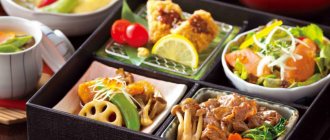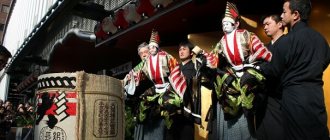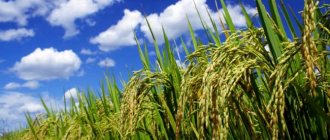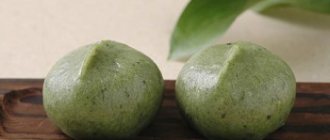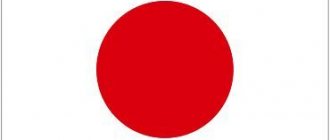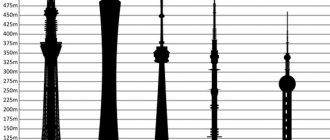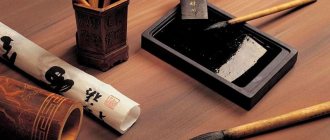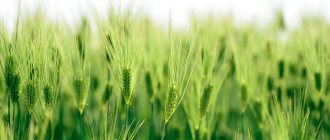The village of Motoyama, where the most delicious rice in Japan is produced, is located in Kochi Prefecture in the center of Shikoku Island. To the north of it is the Ishizuchi mountain range, to the south is the Tsurugi range. You can get there in about an hour by expressway from Kochi town. The source of the Yoshino River is nearby, and in the mountain valley where the village is located there is no shortage of water. We drove onto a narrow forest road branching off from national highway 439, and after about five minutes an amazing landscape suddenly opened up to our eyes - from the foot of the mountains to almost the tops of the mountains stretched terraced fields, on which ripe rice shimmered golden, awaiting the harvest period.
The terraced fields of the village of Motoyama are located at an altitude of 250 to 850 meters above sea level. It’s not for nothing that the local rice is called “Tosa Tenku no Sato Nikomaru” - “Nikomaru from the Heavenly Village in the Land of Tosa.”
Rice is grown in the traditional way - it's expensive
Japanese rice is grown in the traditional way - the fields are flooded with water and sown with rice grains. Rice grains germinate well in water, but weeds do not. Rice in the fields grows by itself without artificially accelerating growth, without chemical fertilizers.
Good yields are ensured by a large growing area and repeated sowings. The state regulates the amount of cultivated land, so you cannot plant more than what is allowed, otherwise rice prices will fall and the economy will crash. Such traditional growing methods do not benefit the price per bag. Rice that is grown without such technologies can be grown faster and cheaper. But for the Japanese this is unacceptable.
Lyrical digression
Rice in Japan is considered a matter of national pride and when the Japanese cook rice, they seem to do it with a breath, as if it is not just a grain, but something very special. The way it is. Rice is the symbol of the state and the soul of the nation. When Emperor Hirohito was no longer feeling well, he nevertheless considered it his duty to inquire about the rice harvest. And the current monarch transplants rice seedlings into his imperial field every spring, and this is considered an important event, which is covered by almost all newspapers and television channels. And all because over the centuries of existence of the Japanese people, a stable picture of the world has developed - if the rice is heading, then everything else is fine. That is why during World War II, Japanese soldiers were given bento - food boxes filled with rice with a red plum in the middle - as a memory of their homeland.
How to protect terraced fields?
The local population is aging, it is difficult to mechanize rice growing on terraced fields, and recently more and more such fields are being abandoned. Since the early 2000s, farmers in their 30s and 40s have set out to preserve terraced fields. To do this, they teamed up and decided to create a product that could be grown specifically in Motoyama and which could take full advantage of the advantages of these fields - abundant water supply and suitable soils. They were faced with a choice - which of two varieties of rice common in Western Japan should be used for the new product - Koshihikari or Nikomaru? Wada says: “We wanted to show the benefits of the local environment and cultivation methods, so we did not choose rice grown for its special taste, but went with the usual one.”
Much attention was also paid to agricultural technology. All farmers involved in the creation of Tosa Tenku no Sato were certified in organic farming by Kochi Prefecture, so they all used the same information on standards for using pesticides and fertilizers. The older farmers were also happy to share the rice farming experience they had gained over the years.
In addition, in the course of preparing the product for sale, detailed standards for grain size, color, etc. were developed. Typically, rice that is put on sale is sifted through a sieve with a mesh of 1.8 mm, but for Tosa Tenku no Sato a mesh was used at 1.9 mm. Only large grains are sold. Farmers also entered products into tasting competitions in department stores and took consumer opinions into account in the process of growing rice.
Ooishi Naoya, a farmer who worked with Wada to create the product, talks about his experience: “These terraced fields are our homeland. I wanted to keep them at all costs, and to do this I needed to earn income from them. I turned to the young farmers still remaining in the village, and we decided to create Tosa Tenku no Sato. We used to be told that rice from Shikoku would not be sold, but we really wanted to make our own, local good rice. I was very happy when, during a tasting at the department store, I heard from a customer that the rice was delicious.”
High cost
The cost of rice grown in Japan is so high that, according to all market laws, it cannot withstand competition with cheaper varieties. A kilogram of inexpensive Japanese rice costs 500 yen - 356 rubles.
However, the government, with the support of the vast majority of the population, stubbornly continues to finance production. And exclusively for reasons of national prestige. Because “real” rice grows only in Japan.
Lyrical digression
The Japanese believe that if you didn’t eat rice at lunch, then it’s as if you didn’t sit down at the table. Therefore, in Japanese, food and cooked rice are referred to by one word - gohan.
Rambler describes a situation where the price of Japanese rice could be reduced, but somehow it still isn’t.
Agricultural technology for growing rice in Japan
Compost or pus is spread over the field, which is then flooded and, after plowing, the soil takes on the consistency of pea soup. Then, according to the traditional method, rice seeds are sown in this prepared nursery. When the rice plants reach approximately 20 cm in height, they are transplanted into the field by hand, then the soil is lightly loosened between the rows, weeded and mulched by hand. The field remains flooded with water for three months. In this case, the layer of water above the soil surface reaches 2.5 centimeters or more. The harvest is harvested using combines or manually with sickles. After harvesting, the field is plowed and the soil is formed into flat ridges about 0.5 m wide, separated by drainage furrows.
Rye and barley seeds are scattered over the surface of the ridges and embedded in the soil. Of course, this is possible with well-planned soil and a constant supply of essential nutrients.
It should be noted that using the traditional method, Japanese farmers grew rice and winter grains every year in the same field for centuries without reducing soil fertility.
Fuku oka sows rice, white clover and winter grain seeds simultaneously in the same field in the fall and covers them with a thick layer of rice straw. Barley (or rye) and clover germinate immediately, rice seeds remain dormant until spring.
Rye and barley are harvested in May and spread out to dry for 7-10 days. Then they are threshed, the grain is winnowed and put into bags. Straw is spread across the field as mulch. Water is kept on the fields for a short time during the June monsoon rains to weaken clover and weeds and allow rice seeds to germinate through the straw mulch. After the water is drained from the field, the clover grows under the cover of the rice. From then until the harvest, Fuku oka maintains drainage ditches and narrow footpaths between the fields. Rice is harvested in October and receives from 50 to 58 c/ha.
All three methods (natural, traditional and chemical) give the same yields, but differ significantly in their effect on the soil. The soil in Fukuoka's fields is getting better every season. Over the past 25 years since he stopped plowing, the fertility of his fields has been steadily increasing, improving the structure and water-holding capacity of the soil. With the traditional method, soil fertility, as already noted, remains at the same level for many years and its value is proportional to the amount of compost and manure applied. With the chemical method, the soil becomes sluggish and its natural fertility is quickly destroyed.
The Fukuoka method allows rice to be grown by flooding fields for the entire growing season. Moreover, each rice plant produces 250-300 grains.
Using mulch increases the soil's ability to hold water. According to Fukuoka, the natural method will help completely eliminate the problem of irrigation and restore soil fertility damaged by improper processing or chemicals.
During autumn sowing, rye and barley seeds are scattered over the surface of the field, while rice is still growing on it. After a few weeks, the rice is removed and the rice straw is scattered over the surface.
The same for rice: winter grains are cut around May 20; two weeks before harvesting, rice seeds are scattered across a field occupied by rye and barley.
After harvesting winter grains, barley and rice straw are scattered on the fields. It is believed that the use of the same method of sowing rice and winter grains is a unique feature of natural crop production. Fukuoka notes that there is no need to plow the land, apply fertilizers, make compost, or use insecticides. The reason why constant improvement in crop technology seems necessary is that the natural balance has already been so greatly disturbed by modern technology that the earth is becoming dependent on it. Natural crop production has always existed, like a spring well from which agriculture begins.
Rice has been grown in Japan for centuries. In any corner of the country you can admire the landscape of a rice field dotted with light green rice sprouts. In the old days, the picture was completed by peasants in wide-brimmed hats and peasant women with tied hems of their clothes, standing ankle-deep in water. Now such farmers can only be seen on small private fields, while on large ones they use machinery. The sight of a rice field for a Japanese is the same as a wheat field for a Russian. It caresses the eye and soothes the soul.
In Japan, less than 5% of the population is engaged in agricultural work, providing the Japanese with about 86% of vegetables, 50% of fruits and 100% of rice.
It is believed that rice came to the south of Japan through Southeast Asia, the Korean Peninsula and Taiwan during the Jomon era (about 10 thousand years BC - 4th century BC) and Yayoi (about 4th century BC) AD - III century AD). The population of Japan at that time was engaged in gathering and hunting, moving around the country in search of areas richest in food. With the advent of rice, enormous changes occurred in the Japanese way of life. Each family settled in a specific area because it could grow rice and eat it without moving from place to place in search of more and more forests that provide food. At first, the Japanese ate brown rice by roasting it over a fire. In the next era, they began to steam rice. Then, having learned the art of cleaning rice, the Japanese began to eat white rice without the husk.
Rice requires special care; it is a very moisture-loving crop. In a good year, they manage to harvest two crops per season. The soil is prepared for planting by planting with clover or other flowers, and then filled with water and sown with rice grains. Before the first shoots emerge, the rice fields resemble shallow lakes. Frogs live in their water, so at night a loud, measured croaking can be heard from the fields, complementing the sound picture of the Japanese night. In past centuries, when the latest technological achievements were still lacking, the fields were worked by hand, so sowers had to stand for a long time in cold water, which was replete with leeches, in addition to frogs. There were always scars left by them on the legs of village girls. However, leeches cleanse the human body by sucking out bad blood, therefore, despite the external unattractiveness of the legs after such therapy, they do not cause harm to health, but even vice versa.
The first shoots appear - and various devices are installed on the field to scare away birds, for example, turntables or circles of cloth that are in continuous movement. Often a kakashi doll is placed at the border of the field,
reminiscent of our scarecrow, which should repel pests.
Such dolls are genetically related to dolls from the ningyo:okuri ritual,
widespread in ancient Japan and performed in some areas of the country to this day.
This ritual is as follows: a procession goes around the field, carrying dolls. It is believed that dolls seem to attract harmful insects. The dolls are then either burned outside the village or lowered down the nearby river to the accompaniment of songs and spells. They are seen off on their last journey, and along with them, harmful insects. Near every village where rice is grown, and sometimes even near the field itself, you can see stone images of the “gods of the field” - hatake no kamisama, which
have a phallic shape and symbolism of fertility.
Japanese rice is strikingly different in shape, color and taste from varieties grown in India or Russia. The Japanese rice grain is snow-white and oval-shaped, but it is not thin and long, but voluminous and small. When cooked, rice does not turn out crumbly, which is a classic epithet for rice all over the world, but, on the contrary, sticky. sushi would hardly have appeared
and
o-nigiri rice balls,
because the rice for them needs to be molded, which is impossible to do if it is not sticky. However, when cast, the grains do not liquefy into a porridge-like mass, but are connected to each other, maintaining their original shape. Unfortunately, you cannot buy such rice in Russia. Even those varieties that are labeled “for sushi” are rarely identical to real Japanese rice. If you still decide to cook sushi in Russia, then “Krasnodar” round grain rice or “For sushi” rice are best suited.
In Japan, rice is very expensive, about 500 yen per kilogram. And this is the cheapest variety. In the Land of the Rising Sun they say that the basis of a good table is rice, so the Japanese never skimp on buying it and purchase the highest quality varieties. In Japan, rice is usually sold in packages of two kilograms or more. For an ordinary Japanese, this amount is hardly enough for a week, since rice complements every meal. There are shops where rice is sold by weight, sometimes even unpeeled, which is good for health. The packaging usually states where it was grown, what month it was harvested and its properties. If a Japanese person falls in love with one type of rice, grown, for example, on the island of Shikoku, then he will forever remain faithful to it. The most popular rice varieties throughout Japan are those grown in Niigata Prefecture, the so-called “rice place” of the country. One of them is the koshihikari variety.
Although rice is grown throughout the country, due to Japan's mountainous landscape, the area still cultivated remains small, accounting for only about 13% of the available land. Therefore, lean years, when the average annual temperature is too low and typhoons rage, turn into a food crisis. In such years, rice is imported from Thailand and India, but it has a completely different taste and is unsuitable for preparing Japanese dishes. In good years, Thai rice can only be bought in stores selling imported products, such as the all-Japanese Yamaya chain, which, by the way, is famous for its cheapness and a rich assortment of foreign wines, and the expensive Meijiya. The Japanese say that Thai rice is frankly unpalatable if it is eaten in its pure form, without seasonings and additives, which is the main way to eat rice in Japan, and not to cook it into pirafa.
(pilaf) or
cha:han
(Chinese-style fried rice with meat or shrimp, eggs and vegetables). In lean years, prices for Japanese rice skyrocket, and although imported Thai rice is much cheaper than Japanese, the Japanese stand in long lines and overpay just to buy Japanese rice. When Japanese travel abroad, many take their native rice with them. At first this is surprising, because this product is easy to buy in any country, but when you get used to Japanese rice and begin to distinguish its taste from other varieties, you understand the Japanese. Japanese rice itself has a rich aroma and a sweetish taste, and you can happily eat it as an independent dish, and not as a side dish, which is unthinkable, for example, with our rice varieties.
Just as a Russian sometimes cannot eat soup without bread, so a Japanese sometimes still feels hungry after lunch without rice. Rice is treated with great respect. In Russia you can’t throw away bread, in Japan you can’t leave rice uneaten to the last grain. Japanese chopsticks, hashi
(in women's speech -
o-hashi),
because only with their help you can grab one small grain of rice. To eat too little rice is disrespectful both to the rice itself and to the host of the table.
Every year on November 23, Japan celebrates Labor Appreciation Day, which originated from the ancient festival of Niinamesai, during which rice from the new harvest was offered to the deities and eaten for the first time of the year by the emperor.
K.G.
Table of contents
How to get there?
Tourists should immediately know that getting to such a picturesque place as the rice terraces is not so easy; it is considered difficult to access. After all, you will first have to go to Wajima, then wait for the local bus, which runs infrequently. Moreover, you should also figure out which one you need to get there by, and what hours to wait for it.
To do this, you need to go to the counter at the station, where the administrator will tell you in detail about the schedule, indicate the bus number and the necessary stop to which you need to go to get closer to the terraces.
Possible harm and contraindications
Despite all its beneficial properties, Japanese rice cannot be considered a cure for diseases. It is consumed in moderation and takes into account the characteristics of the body and concomitant diseases.
The Japanese themselves do not live a single day without rice. They prefer polished white - the most expensive, but not the most useful. The degree of polishing determines how many vitamins and microelements will remain in it.
Brown varieties are affordable. Their taste is less pleasant, but in terms of the presence of useful substances they come first.
There are no special contraindications to eating Japanese rice. Doctors advise type 2 diabetics to eat it with caution, due to its high carbohydrate content. In this case, it is important to take into account the variety and not overuse those that contain a lot of sugar.
Cream cheese
Cream cheeses combine the delicacy of cream, the softness of cottage cheese and, naturally, their usefulness.
Preference is given to three famous brands of cream cheese: Mascarpone, Ricotta, and, of course, Philadelphia. All cream cheeses, including Philadelphia cheese , are soft cheeses that do not require ripening. Their basis is fresh milk enriched with cream. The creamy milk mixture in combination with various starter cultures, in which strains of healthy fermented milk cultures are concentrated, forms cheese compositions of amazing aroma and taste.
Mascarpone
Mascarpone contains easily digestible proteins, vitamins, amino acids, minerals and antioxidants. 41 g of fat were found in this cheese, so its calorie content reaches 412 kcal. It is the fattest among cream cheeses. The carbohydrate content of up to 4.8 g gives the cheese a sweetish taste.
It is customary to make wonderful desserts from Mascarpone: tiramisu and cheesecake. Although this does not at all exclude its use for preparing other delicious delicacies. It is great for making sushi because its structure and taste are almost the same as Philadelphia cheese.
To produce real Mascarpone cheese, high-fat buffalo cream is taken and combined with sourdough and milk. Mascarpone is a natural product; no preservatives are added to it, so the shelf life of this cheese is short - only three days.
Ricotta
Ricotta is made from goat, buffalo, sheep and sometimes cow's milk. This is the lowest calorie cream cheese. Its calorie content does not exceed 174 kcal, and its fat content is 13 g. Ricotta contains only 3 g of carbohydrates. This cheese is a source of healthy proteins and calcium.
He is the leader in the number of proteins. Mascarpone and Philadelphia cheese contain half as much protein in comparison. Ricotta is a dietary product enriched with B vitamins and vitamin A. Sea water used in the production of ricotta gives the cheese a pleasant, slightly salty taste and saturates it with minerals.
It goes well with tomatoes and a variety of other vegetables, and is used in most Italian and Mediterranean dishes. It is used for pancakes and mousses, sushi and cakes. And in the absence of its brother, Philadelphia cheese, it is added to the Philadelphia roll , which acquires interesting flavor notes.
Philadelphia
Comparing Philadelphia cheese with Ricotta and Mascarpone, they note that its calorie content is in the middle. It is much inferior in calorie content to Mascarpone, but much higher in calorie content than Riccotta. This cheese contains 24 g of fat, providing 253 kcal.
In terms of carbohydrate content (3.2 g), it is slightly higher than Riccota, and is an order of magnitude inferior to Mascarpone. The creamy delicacy is rich in minerals, amino acids and vitamins. Its low-fat varieties are an excellent dietary food.
Philadelphia is an indispensable ingredient for many national cuisines. He is loved in every corner of the world. This cheese has long become an integral part of all kinds of desserts, sushi and sandwiches.
A delicious Philadelphia roll is unthinkable without this delicate cheese. It combines so harmoniously with other components of the Japanese dish that the Philadelphia roll owes its name to the cream cheese of the same name.
Rice dishes
In Japanese culture, there is a huge variety of dishes that are made from rice. In addition to traditional rolls in Asian countries, you can try:
- Gohan. Main course with boiled rice. Used as an application for miso soup, pickled and savory dishes. Sometimes used as an alternative for bread. Raw egg and soy sauce can be added to rice.
- Mochi. These are rice cakes that are often prepared for the New Year holidays. They can be used to wrap ice cream filling.
- Onigiri. It is made in the form of spherical buns. They can be wrapped in nori. The filling is filled with pickled Japanese plum, dried mackerel and other goodies.
- Chakhan. Fried rice with onions, pork, carrots and peas.
- Omuraishi. A type of fried rice that is wrapped in an omelette with tomato sauce.
- Chazuke. Boiled rice with fish broth. Served with various pickles, wasabi, salmon, onions and seafood. Often used as a remedy for hangover syndrome. This rice soup helps to cope with headaches and normalize the digestive system after drinking alcoholic beverages.
- Kayu. Rice water, which is used for medicinal and preventive purposes. Includes several medicinal herbs that have a restorative effect.
- Donburi. Rice with vegetables, fish and meat, simmered over low heat. Chicken, egg, and beef are often combined with side dishes. Eel and seafood are sometimes added to donburi.
In the Sushi Wok chain of stores you can taste the most delicious sushi and rolls. Experienced chefs masterfully prepare complex dishes with rice. Experts know how to properly prepare cereal so that it retains all the useful elements and acquires the desired consistency. Our chefs have extensive experience in preparing classic sauces that highlight the flavors of products.

